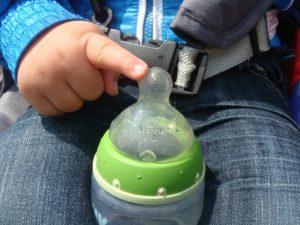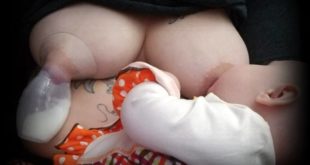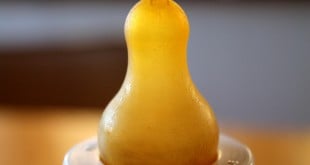 Many babies switch effortlessly between breast and bottle from day one. Others become “nipple confused” if artificial nipples are introduced during the early days of nursing.
Many babies switch effortlessly between breast and bottle from day one. Others become “nipple confused” if artificial nipples are introduced during the early days of nursing.
The mechanics of breast and bottle-feeding are quite different. When a baby nurses, his tongue and jaws must work together rhythmically, cupping his tongue under the areola, and pressing it up against his palate. This flattens and elongates the tissue around the nipple. He then drops the back of his tongue to form a groove for the milk to flow from the nipple to his throat. He swallows, then takes a breath. His lips are flanged out tightly around the breast to form a tight seal.
When a baby drinks from a bottle, the milk gushes out – you’ll notice that the milk drips out if you hold a bottle upside down. In order to keep from choking, he lifts his tongue uses it to block the flow of milk. He purses his lips around the hard rubber nipple, and he doesn’t have to use his jaws at all. There is a constant flow of milk that he doesn’t have to work for, unlike during breastfeeding, where the milk ‘lets down’ initially, then slows to a trickle, and the process repeats as the baby sucks harder and longer. This occurs several times during a feeding, and is one of the reasons breastfed babies are less likely to become obese than bottle fed babies: they regulate their own intake by how long and vigorously they suck. Bottle fed infants will often finish a bottle not because they are hungry, but because they love to suck, and the milk flows so easily.
The risk of nipple confusion, whether by introducing a bottle or pacifier, is greatest during the early days of nursing. The longer you wait to introduce artificial nipples, the less risk there is of confusing your baby. In most cases, breastfeeding has a definite learning curve, although there are some babies who seem to be born knowing exactly what to do. Although sucking is a newborn reflex, the mechanics of effective latching on aren’t. It usually takes a couple of weeks, and sometimes longer, for mothers and babies to get really good at nursing. By that time, any problems you had in the beginning, such as engorgement or nipple soreness, should be pretty much resolved, and your baby’s pattern of weight gain should be established.
If nursing is going along smoothly, there should be no reason to use artificial nipples in the first few weeks of breastfeeding. Nursing frequently and using the breast as a pacifier are what builds a good milk supply and helps you and your baby develop a special closeness during the period immediately after your baby’s birth.
Use the fact that you are exclusively nursing during the first few weeks to get more rest. Let friends and family wait on you, do your laundry, cook for you, etc. You have a perfect excuse. Yes, if you gave the baby bottles, someone else could take over a feeding while you slept, but missing that feeding during the early weeks while you are establishing your supply for your baby who is growing so quickly during that time may decrease your milk production. Once your supply is well established, skipping occasional feedings won’t be a big deal. The period of your baby’s total dependence on you will last for a very short time, although it can seem like forever when you are overwhelmed with the 24/7 responsibility for this little person at a time when you are physically exhausted, emotionally drained, and sleep deprived.
Nobody ever said it would be easy, and if they did, they were either lying, or they never nursed a baby.
Using a pacifier in the early weeks can also cause problems. If you want your baby to take a pacifier, I would introduce it by the time he is one month old, but preferably not during the first two weeks of nursing. Some babies refuse to ever take a pacifier. Some become addicted to them and are still carrying them to Kindergarten. I think that the babies who become attached to pacifiers would have become thumb-suckers or blanket holders if they didn’t attach to a pacifier. Some babies just seem to need security objects, and there isn’t a lot you can do about that. Just because you offer a pacifier to your baby, that doesn’t mean he will develop a bad habit. I have offered pacifiers to all six of my babies, all took them occasionally, and none of them became attached to them. I did have several children who sucked their thumbs for what seemed like forever, but that’s another article.
I think it is great if your older baby will take a pacifier occasionally. If you have ever been driving down the highway with a screaming baby in the backseat and no way to pull over, even though you nursed just before you left, and you KNOW he can’t possibly be hungry, you will know what a wonderful thing a pacifier can be. This especially applies if you have older kids and spend half your waking hours car-pooling. Although I have known some large breasted women who could actually lean over the car seat and let their breast hang in the baby’s mouth, I have never met one well-endowed enough to sling her breast over the back seat to feed her baby. That’s just one example of when a pacifier can be a lifesaver. Another is when your older baby (who is fat and happy and obviously getting enough to eat) has been marathon nursing for hours and nothing is making him happy. Sometimes he just wants to suck himself to sleep, and doesn’t want to nurse. Believe it or not, this does happen. He almost gets angry when the milk comes out, and may settle right down with a pacifier. There also may be times when someone other than you may have to soothe your baby, especially if you return to work and he is in day care with other babies. You really can’t stick a bottle in a baby’s mouth every time he fusses, and caregivers don’t have the breast to use as a built in pacifier. (See Caregiver’s Guide to the Breastfed Baby)
So, I have broken one of the cardinal rules of lactation counseling by saying that I don’t think pacifiers are the devil’s tool. This is because I have survived raising six children, and I know that you do whatever works and helps you keep your sanity. This may or may not include bottles, pacifiers, formula, or a glass of wine.
There are however, some valid concerns about the use (and abuse) of pacifiers. Aside from the risk of nipple confusion, pacifier use is correlated with early weaning for a variety of reasons. Because newborns love to suck on anything put in their mouth, whether it is a finger or an artificial nipple, they may use the pacifier as a substitute for feedings, especially if they are small, ill, jaundiced, or just have a very laid back temperament. There is a spot in the back of a baby’s mouth where the hard palate meets the soft palate. When anything touches it, an automatic sucking reflex is triggered. That’s why babies will suck automatically when a finger or a silicone nipple is put in their mouth. The soft, mushy human nipple must be drawn back in the baby’s mouth until it hits that spot, so use of an artificial nipple may make him somewhat lazy when it comes to nursing.
Some babies are perfectly content to happily miss a feeding as long as they have something to suck on, and some mothers take advantage of this by plugging their baby’s mouth with a pacifier every time he fusses in order to make him sleep longer or go longer intervals between feedings. Young infants should spend their time and energy in nutritive sucking at the breast, not in non-nutritive sucking. Overuse of pacifiers can lead to poor weight gain, plugged ducts and mastitis, and a decrease in milk supply, especially during the first two weeks of nursing. If you have a yeast infection or your baby has thrush, pacifiers can become contaminated. Boil pacifiers every day during a thrush episode, and throw them away after a week. The same thing applies to bottle nipples.
A pacifier really is just an imitation nipple, and as such it should be used in moderation and not as a frequent substitution for the real thing.
Back to bottles now: We’ve talked about the possibility of nipple confusion, and the advantages of waiting until your baby is a few weeks old before introducing bottles. But what if he needs to be supplemented during the early nursing period? This doesn’t happen often, but it occurs often enough that you should be open to the possibility. Some mothers are so afraid of the dreaded ‘nipple confusion’ that they refuse to give bottles, even though that might be the fastest and most efficient way to get milk into their baby when their baby really needs it. By the same token, some mothers feel that if they give formula supplements, they might as well give up and not nurse at all. Ideally, in the best of all possible worlds, all babies would nurse and no one would ever use bottles or formula. However, this is not a perfect world, and we are lucky to have options like bottles and formula when babies really need them. If you baby needs to be supplemented, look at it as a means to an end. Helping your baby gain weight rapidly, while working on increasing your milk supply and continuing to offer the breast, most often results in a baby who nurses stronger and more vigorously at the breast until there is no need for supplements.
If your newborn baby (less than two weeks old) needs to be supplemented, due to medical reasons such as jaundice, low weight gain, or severe nipple soreness, you should try to avoid artificial nipples if at all possible. There are many other options for feeding newborns, including cup feeding, tube feeding, spoon feeding, dropper feeding, or syringe feeding. If long term supplementation is necessary, you may want to use Medela’s SNS (Supplemental Nursing System), or the Lactaid feeding system. These feeding devices consist of a bottle or pouch of milk (breastmilk or formula) that hang down around your neck. A tube attached to the container of milk runs down to the tip of your nipples, and the baby receives the milk while he feeds at the breast. This can stimulate your milk supply while giving your baby the milk he needs, without using a bottle.
When cup, spoon, dropper, or syringe feeding, make sure the baby is awake and alert, hold him in an upright position (you may want to swaddle him if he tends to flail his arms around) and gently pour or squirt in a few drops of milk. He will get the hang of it quickly, and set his own feeding rhythm. Use a towel or cloth diaper to protect his and your clothing – these feeding methods tend to be messy at first.
These types of supplementation work well for many mothers and babies – and dad can help too. If you need to supplement for more than a few days, some alternate methods such as syringe or cup feeding tend to become rather overwhelming, to the point where you may even consider weaning. In that case, I would suggest that you either purchase a supplemental feeding system, or use a bottle.
The most important thing is to get milk into your baby so he will grow and become stronger so he will be able to nurse more effectively. Remember that some babies never become nipple confused, and if this does occur, there are techniques you can use to get him back on the breast. Using a bottle to feed your baby is not the ‘kiss of death’ for breastfeeding, and the most important thing is to lower your stress level and put weight on your baby as quickly as possible. When you are happily nursing six months or two years down the road, it won’t matter one bit that your baby had some bottles in the beginning.
Let’s assume that breastfeeding has gone along just beautifully for you and your baby. He is two weeks old, has regained his birth weight, and your nipple soreness and engorgement are things of the past. You now have a decision to make. If you plan to stay at home with your baby and take him with you wherever you go, and are comfortable nursing in public, you may not care if he ever takes a bottle. In that case, you may not decide to introduce bottles at all. I tend to think that it is better to introduce him to bottles at some point, just in case you have to be separated at some time, you temporarily become too ill to nurse, or you just want to have an occasional night out with your partner.
Your situation is completely different if you know that you will have to return to work or school. In that case, you need to introduce bottles no later than one month, and earlier if you are returning to work at six weeks or sooner.
If you know that you want to have the option of giving your baby bottles, this is what I recommend:
- At 3-4 weeks (or 2-3 weeks if you are returning to work at 6 weeks), you can begin pumping after feedings for 4-5 minutes if your baby had a good feeding, or 8-10 minutes if he didn’t nurse well or only nursed on one breast. This will get out the rest of the high calorie, fatty hind milk, and will not interfere with your baby’s nursing schedule. With babies this young, it’s hard to nurse between feedings because they’re usually not on that much of a schedule – you may nurse them and have 2-4 hours before they are ready to nurse again, or they want to nurse again an hour after their last feeding.
- If your baby consistently only takes one breast at a feeding, you can pump the other breast, but if you do this too often, you may end up with an oversupply of milk. Mom’s whose babies only take one side at a feeding generally have lots of milk to begin with.
- Pumping for a few minutes after nursing is the equivalent of the baby nursing for a few more minutes on each side, and will not significantly increase your supply, although repeated stimulation will increase it a little. In order to increase your supply significantly, as in the case of the baby who isn’t gaining weight, you need to pump after feedings about 8 times a day or more. The type of pump you use is important here – small electric pumps or manual pumps are not good at getting out the last little bit of milk left between feedings, but may be fine for very occasional use when your breasts are full. You really need the stimulation of a good electric pump that allows you to double pump. There are hospital grade pumps you can rent, or professional grade pumps you can buy.
- The amount you will get when you pump after feedings will vary significantly, depending on variables such as your individual milk supply; (some mothers have enough milk for triplets, others barely enough for one baby, with most mothers falling somewhere in between those extremes); how long it has been since the baby nursed; whether he took one breast or two at the last feeding; and the time of day (you tend to get more milk in the morning, with your supply decreasing to its lowest levels late in the day). Some mothers pump for just a few minutes after a morning feeding, and get several ounces. If you are one of those mothers, you may only need to pump once each day and you will have your daily bottle, which you can either offer it to your baby to get him used to bottles, or save for when you go back to work. Other mothers may get 1/4 to1/2 ounces when they pump after the baby nurses, and they may have to pump several times a day to get a bottle. If you are using a good electric pump, even if you have to pump 5 times a day to get a bottle, you have still only spent less than an hour pumping, and you have your bottle for the day. You won’t know how much you’ll get until you try. When you are pumping in multiple sessions, be sure to cool the milk you just pumped before adding it to the milk you pumped previously.
- If you are bottle feeding a newborn, I recommend a slower flow nipple. If you are offering the bottle to an older baby, I don’t think the type of nipple is really important. When they go back to the breast, babies older than a few weeks are very unlikely to forget how to nurse just because you gave them an artificial nipple.
- There are countless different kinds of nipples and bottles on the market, and I don’t recommend any of them over another. They all claim to be the closest thing to nursing at the breast, and this just isn’t true. Think about it – if someone had really come up with a bottle or nipple that really eliminated swallowing air, nipple confusion, spitting up, or any of the other things they claim to do, don’t you think that everyone would use them? It wouldn’t be a secret for long. Bottles and nipples are always going to be a substitute for the real thing, any way you look at it. There is no ideal bottle, despite of what the manufacturers claim.
- Try offering the bottle when your baby isn’t starving. This may seem illogical, but when a baby is frantically hungry, he is going to be in no mood to try something new. He just wants to nurse.
- Try having someone else offer the bottle at first. Your baby associates your smell and touch with nursing, and may insist on the real thing if you try to give him a bottle. You may have to leave the room entirely in order for the effort to be successful. Let Dad try, and if that doesn’t work, let an experienced bottle feeder try. You’d be amazed at how many babies refuse to take bottles at home, but will take them willingly at day care where the provider approaches the process matter-of-factually. Encourage the caregiver to cuddle the baby while offering the bottle, but usually it is better to avoid the cradle position
- Many babies associate the cradle hold, where they are cuddled against the breast, with nursing, and will refuse to accept the bottle as a substitute. This is especially true of newborns. Have you ever seen someone hold a hungry nursing infant in the nursing position? It doesn’t matter if the caregiver is male or female, nine years old or ninety, a young baby will turn his head, root, and try to nurse. Although some babies will accept a bottle more readily in the nursing hold, most will do better if you prop them up on your knees or in an infant seat, and make eye contact while feeding them.
- Offer a small amount at first. If he takes it readily, you can always offer more. If he doesn’t take it, you won’t have wasted much of your ‘liquid gold’. Even taking a few sips is a step toward accepting the bottle.
- You don’t have to substitute a bottle feeding for an entire nursing. In the beginning, have dad try giving an ounce or two in the evening while your supply is lowest and you are the most in need of a break. Leave the room. Take a hot bath. Hope that it works.
- Some babies will take the bottle more readily if you move rhythmically while walking, swaying, rocking, and/or talking to them to distract them.
If your baby is resistant to taking the bottle (this is seldom a problem in babies less than 4-6 weeks old), try:
- Feeding him when he is half asleep.
- Different nipples. Some babies prefer a slow flow nipple, some a faster flow. Slower flow nipples may be an advantage in a newborn, but a disadvantage in an older, more impatient baby.
- Making sure the nipple isn’t cold when you offer it. Many babies couldn’t care less if the milk you give them is cold (and it doesn’t cause digestive problems – that’s an old wives tale) but they don’t like the feel of a cold rubber nipple in their mouth. Run it under warm water before you offer it. Newborns especially don’t like cold nipples. Sometimes older,teething babies like having a cold nipple to bite down on, so once again, you’ll just have to experiment and see what works for your baby.
- Some older babies with discerning tastes will refuse to take milk in a bottle, and can be very stubborn about it. It’s almost as though they know that milk is supposed to come from breasts, and they won’t take it any other way. Formula is a whole different thing. It tastes nasty, especially the pre-digested stuff like Alimentum. Progestimil , or Nutramigen – these are products for babies who have problems digesting regular formula, and they taste and smell like spit-up. They also cost a small fortune. I saw a one pound can of Alimentium formula on the internet selling for $129.99, plus shipping. Apparently this was great deal because it was on sale. The regular price was $179.00. Wow. Did you know that many insurance companies will pay for the cost of hypoallergenic formulas, but not for electric breast pumps? Makes no sense to me, especially since these special formulas claim to be ‘designed to be more like breastmilk’.
- One difference between formula and breast milk (besides the obvious nutritional deficits of formula) is that breast milk tastes better. It’s kind of like the difference between powdered or evaporated milk and regular cow’s milk – they may have similar nutritional content, and you can use them in a pinch, but everybody knows that they don’t taste the same. Breast milk is quite a bit sweeter than formula. I’ve heard a toddler describe it as tasting like ‘melted ice cream’. If you can overcome your squeamishness, taste it sometime. It really does taste better than formula.
- Most babies will take breast milk more readily than they will take formula, but if you have a baby who is really picky, try offering a little bit of apple juice mixed in water. A few drops of apple juice is not going to hurt him, even if he’s only a few months old and not ready for solids yet. If you can get him to take a few sips of juice, try mixing milk with the juice a teaspoon at a time until you have more milk than juice. Then cut the juice out completely.
- When offering the bottle, tickle the baby’s lips gently with the nipple until he opens his mouth and explores the nipple. Don’t try to force it into his mouth.
- If your baby is older than a month or two when you offer the bottle, and he refuses it completely, try cup feeding. Many older babies bypass the bottle completely during separations from mom and do well with the cup. As long as they are nursing most of the time, their sucking needs will be met.
For more information, see Pumping and Storing Breastmilk.
(Edited September, 2015)
*Pay it Forward’!*
If you found this article helpful, please consider making a small donation to my favorite cause – Project Pets:Spay, Neuter, Love – an all volunteer, non-profit organization that provides free spay and neuter services for homeless rescue dogs and cats…because every baby deserves a home, whether they have two legs or four! Find out more about how you can help by visiting Project Pets on Facebook.
Anne Smith, IBCLC
Breastfeeding Basics
If nursing is going along smoothly, there should be no reason to use artificial nipples in the first few weeks of breastfeeding. Nursing frequently and using the breast as a pacifier are what builds a good milk supply and helps you and your baby develop a special closeness during the period immediately after your baby’s birth.
 Breastfeeding Basics
Breastfeeding Basics





